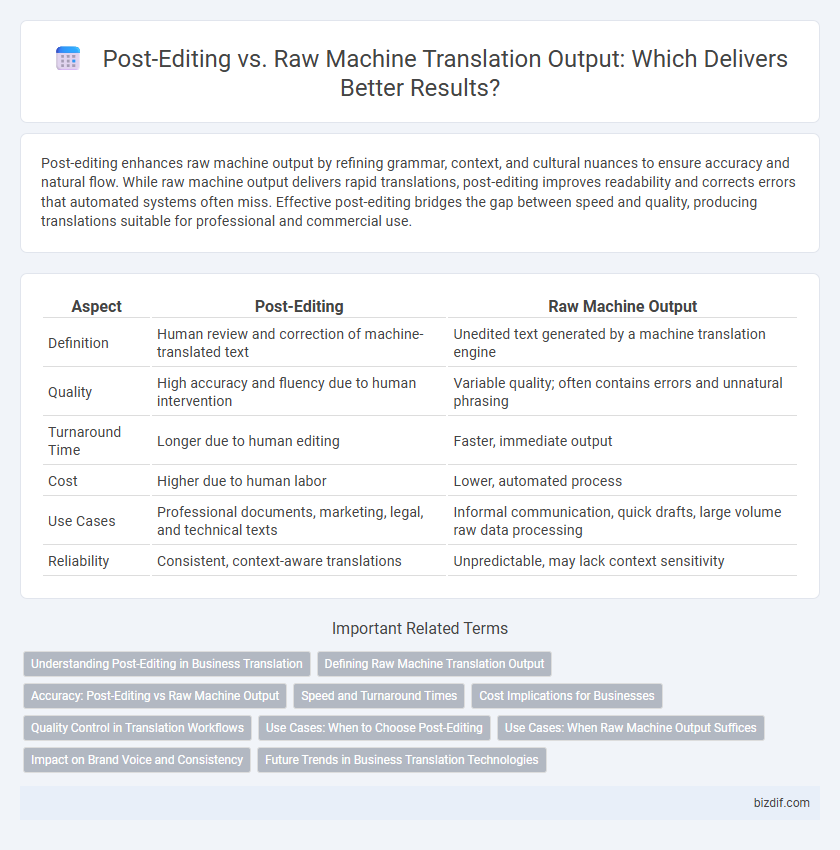Post-editing enhances raw machine output by refining grammar, context, and cultural nuances to ensure accuracy and natural flow. While raw machine output delivers rapid translations, post-editing improves readability and corrects errors that automated systems often miss. Effective post-editing bridges the gap between speed and quality, producing translations suitable for professional and commercial use.
Table of Comparison
| Aspect | Post-Editing | Raw Machine Output |
|---|---|---|
| Definition | Human review and correction of machine-translated text | Unedited text generated by a machine translation engine |
| Quality | High accuracy and fluency due to human intervention | Variable quality; often contains errors and unnatural phrasing |
| Turnaround Time | Longer due to human editing | Faster, immediate output |
| Cost | Higher due to human labor | Lower, automated process |
| Use Cases | Professional documents, marketing, legal, and technical texts | Informal communication, quick drafts, large volume raw data processing |
| Reliability | Consistent, context-aware translations | Unpredictable, may lack context sensitivity |
Understanding Post-Editing in Business Translation
Post-editing is a critical process in business translation where human translators refine raw machine output to ensure accuracy, cultural relevance, and brand consistency. This method reduces turnaround times and costs compared to traditional translation while maintaining high-quality results essential for corporate communications. Understanding the balance between automated efficiency and human expertise optimizes multilingual content for global markets.
Defining Raw Machine Translation Output
Raw machine translation output refers to the initial, unedited text generated directly by a machine translation engine without human intervention. This output often contains errors such as mistranslations, grammatical mistakes, and lack of contextual accuracy, making it less reliable for immediate use. Understanding the limitations of raw machine translation emphasizes the importance of post-editing to improve quality and ensure the text meets specific linguistic and cultural standards.
Accuracy: Post-Editing vs Raw Machine Output
Post-editing significantly enhances translation accuracy compared to raw machine output by correcting contextual errors, idiomatic expressions, and syntax mistakes. While raw machine output often contains literal translations and ambiguous terms, post-editing refines these elements to better reflect the source message's intent and cultural nuances. Accuracy improvements through post-editing result in higher-quality, reliable translations suitable for professional and commercial use.
Speed and Turnaround Times
Post-editing significantly improves translation speed and turnaround times by refining raw machine output quickly while maintaining quality. Raw machine output delivers immediate translations but often requires extensive revision to ensure accuracy, which can delay project completion. Leveraging post-editing balances rapid delivery with precision, making it ideal for fast-paced translation workflows.
Cost Implications for Businesses
Post-editing machine translation significantly reduces the need for extensive human translation, lowering overall project costs while maintaining quality. Raw machine output, though cheaper initially, often requires substantial revisions, which can increase expenses and delay delivery. Businesses benefit from post-editing by balancing affordability with accuracy, enhancing efficiency in multilingual content production.
Quality Control in Translation Workflows
Post-editing enhances raw machine output by refining linguistic accuracy and contextual relevance, ensuring higher translation quality. Implementing quality control protocols during post-editing reduces errors and improves consistency across translated content. Efficient integration of post-editing in translation workflows streamlines project delivery while maintaining client satisfaction through superior quality standards.
Use Cases: When to Choose Post-Editing
Post-editing is ideal for technical documentation, marketing materials, and legal texts where accuracy and tone are crucial. Raw machine output may suffice for quick, non-critical translations such as user-generated content or internal communications. Selecting post-editing improves quality and consistency, ensuring the final text meets professional standards.
Use Cases: When Raw Machine Output Suffices
Raw machine translation output is sufficient for use cases such as internal communication, quick comprehension of foreign texts, and monitoring multilingual content where accuracy is not critical. Sectors like social media analytics, real-time data tracking, and informal customer interactions often utilize raw machine output to save time and costs. This approach is effective when the goal is to grasp the general meaning rather than produce publication-quality translations.
Impact on Brand Voice and Consistency
Post-editing machine translation ensures that brand voice remains consistent by refining raw machine output to align with company tone and style guidelines. Raw machine output often lacks cultural nuances and emotional resonance, which can dilute brand identity and lead to inconsistent messaging. Effective post-editing enhances clarity, maintains terminology accuracy, and preserves brand personality across all translated content.
Future Trends in Business Translation Technologies
Post-editing of machine translation (MT) outputs enhances accuracy by integrating human expertise with AI-driven language models, addressing nuances and cultural context missed by raw machine output. Future business translation technologies will increasingly leverage neural machine translation (NMT) combined with adaptive learning algorithms to customize translations for industry-specific terminology and client preferences. Integration of AI-powered quality estimation tools will streamline post-editing workflows, reducing turnaround times and operational costs while maintaining high translation quality.
Post-Editing vs Raw Machine Output Infographic

 bizdif.com
bizdif.com